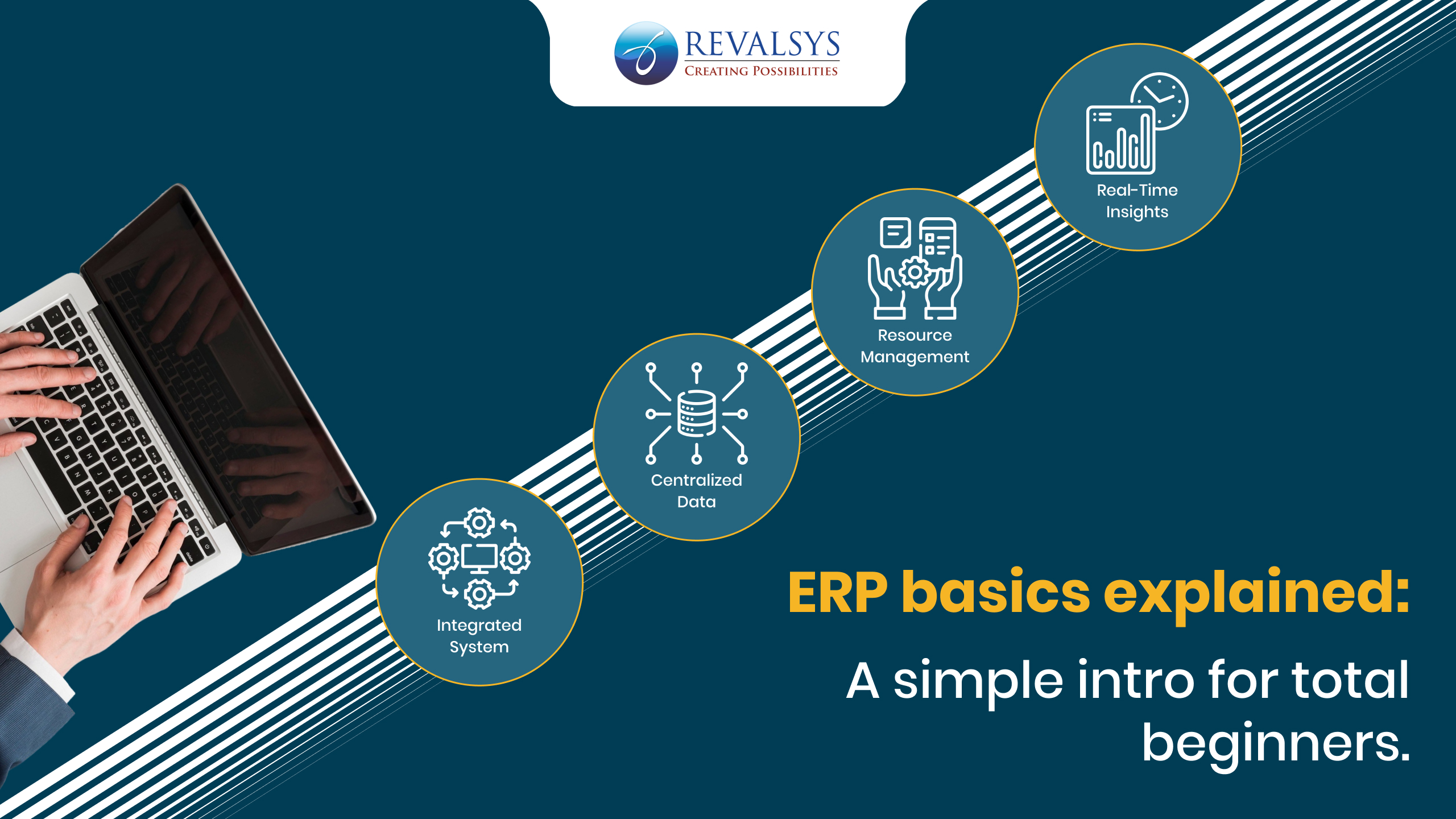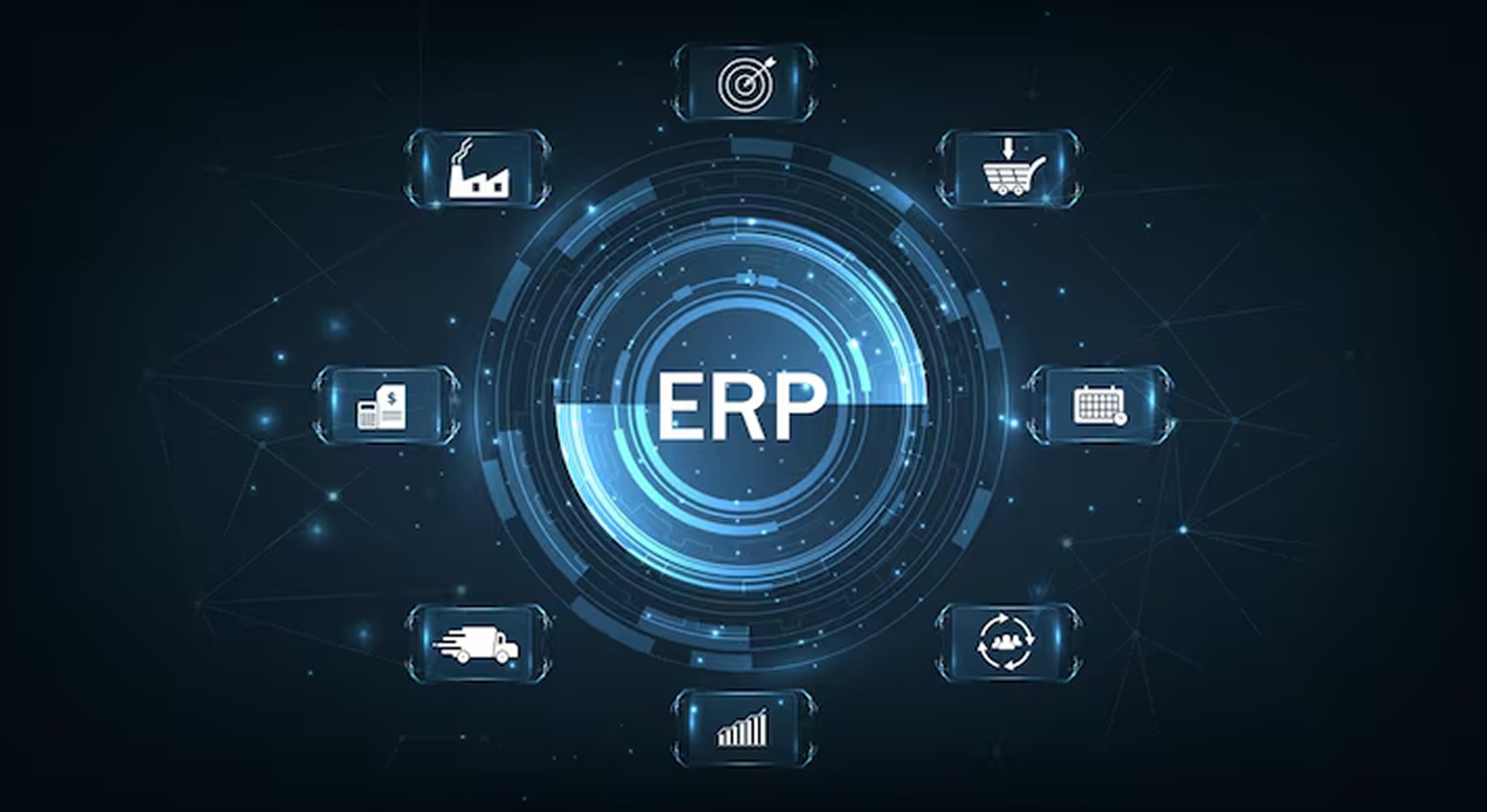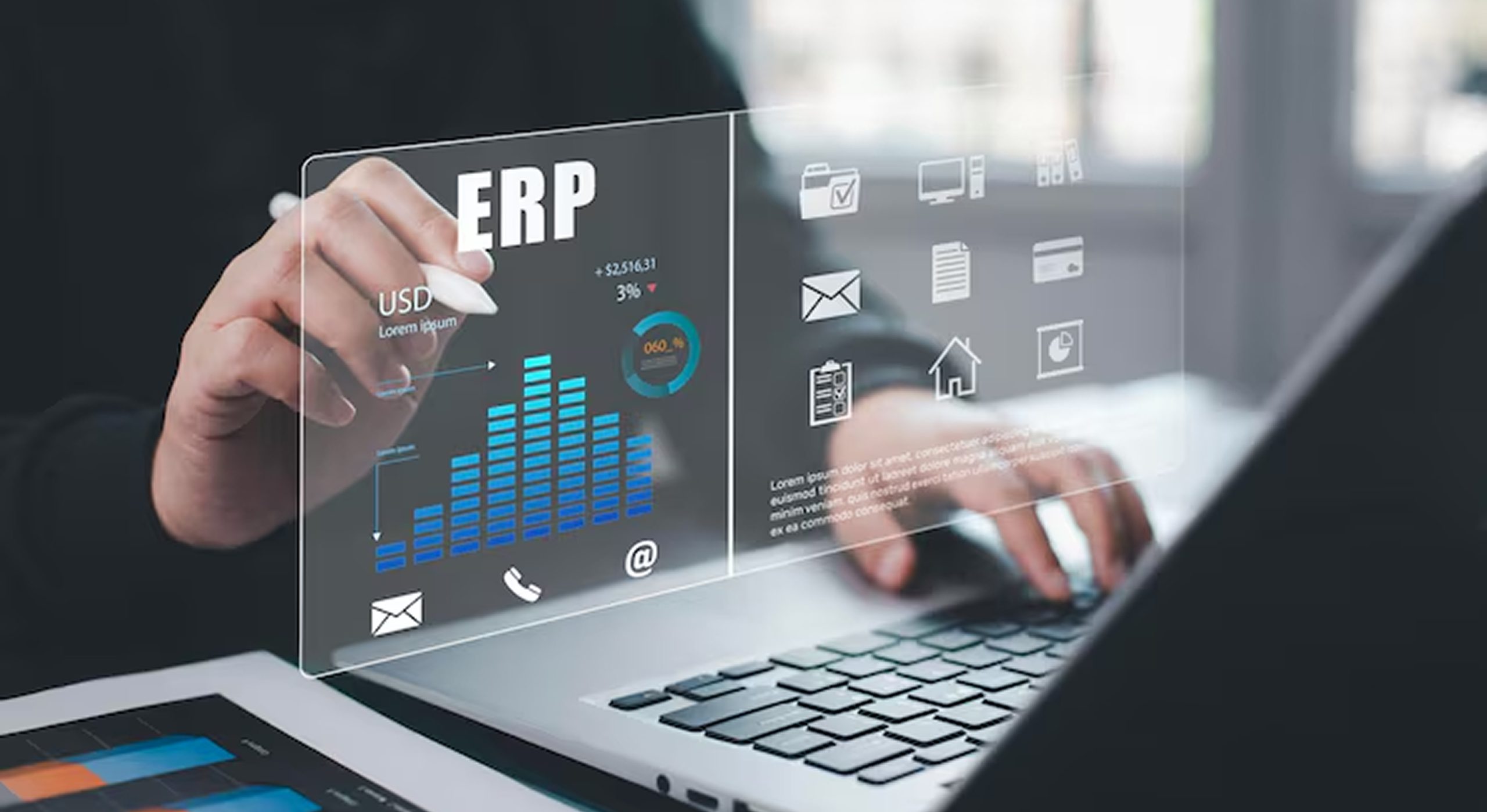
Picture this you’re running a growing business. Your sales team uses spreadsheets, your accounts team uses another tool, HR maintains attendance separately, and your warehouse tracks stock manually. Every day feels like a puzzle, data scattered everywhere, mistakes happening often, and reports taking forever.
Now, imagine if one single system could connect all these departments updating data in real time, automating tasks, and showing you exactly what’s happening in your business.
That’s exactly what ERP (Enterprise Resource Planning) does. In this guide, we’ll simplify ERP for you what it is, how it works, why it’s crucial, and how it can help businesses of any size run smoother and smarter.
What Exactly is ERP?
ERP stands for Enterprise Resource Planning — a system that helps a business plan, manage and automate its daily operations across departments. ERP is a single software system that connects all areas of a business finance, HR, inventory, sales, supply chain and more into one integrated platform.
Instead of using different tools for sales, HR, finance and production, an ERP brings them all together on a single platform.It’s like giving your business a digital brain one that keeps everything connected and in sync.
In Simple Words:
ERP = One System. One Database. Real-Time Information for Everyone.
A Quick Example:
Let’s say your sales team closes a new order.
With ERP:
- The inventory team instantly sees how much stock is needed.
- The production team starts scheduling manufacturing.
- The accounts team automatically generates the invoice.
- The management team views updated revenue in real time.
No manual coordination, no data errors, no back-and-forth emails No spreadsheets. No confusion. Everything happens in one smooth flow.
That’s what magic of ERP — connect, automate, and simplify.
A Short Journey: How ERP Evolved
ERP systems didn’t just appear overnight. They evolved over decades as businesses became more complex and needed better control.
In the 1960s, companies used simple software just to manage inventory. By the 1970s, they started using MRP (Material Requirement Planning) systems to plan production. The 1980s introduced MRP II, which included HR and finance too.
Then came the 1990s the era of Enterprise Resource Planning (ERP) which combined all business functions into one powerful system.
Today, ERP has gone even further. With cloud technology, AI, and mobile access, ERP systems are now smarter, faster, and accessible from anywhere.
The Core Modules Inside an ERP
 Think of ERP as a toolkit with several modules, each handling one department but connected to the same data source.
Think of ERP as a toolkit with several modules, each handling one department but connected to the same data source.
Here’s what typically comes inside:
1. Finance & Accounting
The financial backbone of your business.
Manages everything from income, expenses, budgets, to balance sheets. Features:
- Ledger management
- Accounts payable/receivable
- Expense tracking
- Financial reports
2. Human Resource Management (HRM)
Keeps your workforce data organized. Features:
- Employee profiles & attendance
- Payroll processing
- Leave management
- Performance tracking
3. Inventory & Warehouse Management
Tracks every item coming in and going out. Features:
- Real-time stock tracking
- Reorder alerts
- Barcode integration
- Expiry & batch tracking
4. Sales & Customer Relationship Management (CRM)
Your sales team’s best friend! Features:
- Lead & deal tracking
- Customer communication
- Quotation & billing
- After-sales service
5. Procurement & Supply Chain
Simplifies vendor and purchase management. Features:
- Vendor database
- Purchase orders & approvals
- Supplier performance reports
6. Manufacturing / Production
Ideal for manufacturing businesses. Features:
- Bill of Materials (BOM)
- Production planning
- Quality checks
- Resource utilization
7. Project Management
Keeps projects on track from start to finish. Features:
- Task tracking
- Budget monitoring
- Progress dashboards
All modules work together so data entered in one area updates everywhere automatically.
How Does ERP Actually Work?
Let’s break it down into four easy steps:
Centralized Database:
In an ERP system, all departments from sales to HR access and update information from a single shared database. This eliminates data duplication and ensures that everyone works with the same, most recent data. It creates a seamless flow of information across the organization, improving collaboration and accuracy.
Real-Time Updates:
ERP systems keep everything in sync by updating data instantly across departments. For instance, when a sale is made, the stock levels, financial accounts, and production schedules are automatically updated in real time. This transparency allows teams to react quickly to changes and maintain operational efficiency.
Automated Processes:
With ERP automation, routine and repetitive tasks like billing, payroll, and inventory updates happen automatically. This not only reduces manual errors but also saves employees valuable time, allowing them to focus on more strategic work. Automation enhances productivity and ensures smoother day-to-day operations.
Analytics & Reporting:
ERP systems go beyond storing data—they transform it into powerful insights. With built-in analytics and reporting tools, managers can view real-time dashboards, performance metrics, and forecasts. These insights support faster, smarter decisions and help businesses stay ahead of challenges.
Essentially, ERP acts as the digital command center for your organization.
Types of ERP Systems (Choose What Fits You Best)
Different businesses need different ERP setups. Here are the three main types:
Cloud ERP:
Cloud ERP systems are hosted online, allowing users to access business data anytime, anywhere, using just an internet connection. They are cost-effective, easy to scale as the business grows, and come with automatic updates handled by the service provider. This makes them an ideal choice for startups and small to medium-sized businesses looking for flexibility without heavy infrastructure costs.
On-Premise ERP:
On-premise ERP solutions are installed directly on a company’s own servers and managed internally by the IT team. They offer complete control over data, system configurations, and security settings, making them highly customizable. Such systems are best suited for large enterprises that require strict data control, high-level customization, and have the resources to manage in-house IT infrastructure.
Hybrid ERP:
Hybrid ERP combines the best of both worlds—cloud convenience and on-premise control. It allows businesses to keep sensitive operations on local servers while leveraging the scalability and accessibility of the cloud for other processes. This model is perfect for companies in transition or those operating across multiple locations, offering flexibility and smooth data integration.
Why Businesses Need ERP (The Real Reasons)
 Let’s face it running a business without ERP today is like managing a city with no traffic lights. It might work, but chaos is just around the corner.
Let’s face it running a business without ERP today is like managing a city with no traffic lights. It might work, but chaos is just around the corner.
Here’s what ERP helps you achieve:
Smarter Decision-Making:
Real-time dashboards give leaders instant visibility into business performance, eliminating delays from weekly reports.
Efficiency Through Automation:
ERP automates repetitive tasks like billing and data entry, saving valuable time and minimizing human error.
Seamless Collaboration:
With all departments connected through a single system, teamwork becomes faster, smoother, and more transparent.
Reduced Operational Costs:
By minimizing errors and optimizing processes, ERP systems help businesses save significantly on operational expenses.
Happier Customers:
Accurate order processing, quicker deliveries, and improved service quality lead to greater customer satisfaction.
Business Scalability:
ERP grows alongside your business — easily adding new modules, users, or functionalities as your needs expand.
ERP Implementation: The Step-by-Step Roadmap
Implementing ERP is a journey — not a switch you flip overnight.
Here’s a simplified roadmap most companies follow:
- Planning: Define goals, timeline, and select the right ERP partner.
- Process Study: Understand current workflows and identify gaps.
- Customization: Configure modules as per your business model.
- Data Migration: Move data safely from spreadsheets or legacy systems.
- Testing & Training: Ensure everything works and employees are comfortable.
- Go Live: Launch the system officially.
- Support & Maintenance: Continuous improvements and updates.
ERP for All Sizes: Big or Small
One of the biggest myths is that ERP is only for large corporations. Not anymore!
For Startups & Small Businesses
- Affordable cloud ERP options available
- Helps track sales, stock, and finances effortlessly
- Automates repetitive tasks to save time
For Medium Enterprises
- Enhances inter-department collaboration
- Offers scalability as you grow
- Provides actionable business insights
For Large Corporates
- Standardizes operations across branches
- Enables predictive analytics
- Ensures compliance and data security
No matter your business size, ERP helps you work smarter, not harder.
The Future of ERP: Smarter Than Ever
The next generation of ERP systems is intelligent and predictive — not just reactive. Here’s what’s shaping the future:
AI & Machine Learning:
Modern ERP systems use AI and machine learning to analyze patterns, predict future sales, detect fraud, and improve operational efficiency. These smart insights help businesses make proactive decisions rather than reacting to problems later.
Mobile ERP:
With mobile ERP, you can access dashboards, approve purchase orders, and review reports directly from your smartphone. It keeps business leaders connected and productive anytime, anywhere.
IoT Integration:
ERP systems now connect seamlessly with IoT-enabled machines, sensors, and devices for real-time tracking. This integration boosts accuracy, minimizes downtime, and provides instant visibility into operations.
Blockchain & Security:
Blockchain technology ensures every ERP transaction is secure, transparent, and tamper-proof. It’s especially valuable for finance, logistics, and supply chain operations where trust and data integrity are critical.
The Future of ERP:
ERP is no longer just a management tool—it’s evolving into a digital business advisor. With AI, mobility, IoT, and blockchain, it empowers companies to operate intelligently and stay future-ready.
Key Takeaways: Why ERP Matters More Than Ever
- ERP unites your entire business under one system.
- It gives real-time visibility, saves time, and reduces errors.
- It helps businesses grow faster and stay competitive.
- With cloud and AI, ERP is now affordable for everyone.
Final Thoughts: ERP Is the Heartbeat of Modern Business
In today’s digital-first world, ERP isn’t a luxury — it’s a necessity.
It helps you see clearly, act quickly, and grow confidently.
Think of it like this your business is the body, your departments are organs and ERP is the heartbeat that keeps everything connected and functioning.
So whether you’re a small business trying to organize your processes or a large enterprise seeking efficiency, an ERP system is your path toward smarter management and sustainable success.
Start small, scale fast, and let ERP do the heavy lifting.
